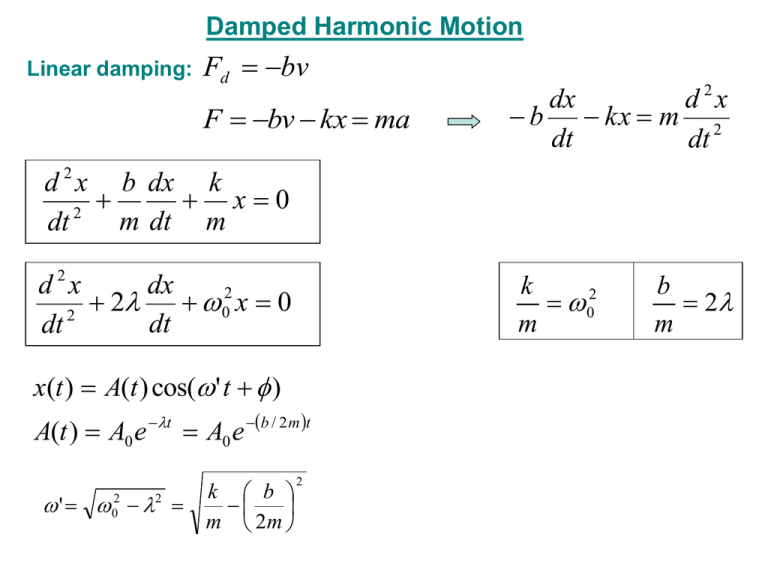bv F
advertisement

Damped Harmonic Motion Linear damping: Fd bv F bv kx ma dx d 2x b kx m 2 dt dt d 2 x b dx k x0 2 m dt m dt d 2x dx 2 2 0x 0 2 dt dt k 02 m x(t ) A(t ) cos( ' t ) A(t ) A0 e t A0 e b / 2 m t ' 02 2 k b m 2m 2 b 2 m Three types of solutions: 1. Underdamping b 2 x A(t )cos(t ) x(t) b1 > b2 T 1 > T2 with km A(t ) Ae (b /2m )t k b2 m 4m 2 Similar to ideal SHM except: • period of oscillation lengthened • exponential decay in amplitude A(t) t A(t) x(t) 2. Critical damping b 2 km k b 2 0!! m 4m 2 No oscillations! t 3. Overdamping b 2 km No oscillations either. The decay is slower than with critical damping. x(t) b 2 km b 2 km b 2 km t Forced Oscillations and Resonance Damping is always present To keep a system going, we need to apply a driving force. Fext Fmax cos( d t ) For a driving force of the form: the amplitude is A Fmax m 2 0 b 2 2 d m 2 d Resonance When d k 0 m amplitude, A is very large, even for small Fmax (without damping, ie b = 0, A → ∞). 0 - natural frequency Fmax d 2 x b dx k x cos d t 2 m dt m m dt x(t ) A0 e b / 2 m t cos( ' t ) A cos(d t ) Waves There are many examples of waves: - Seismic waves - Ripples on a pond - Sound - Electromagnetic wave including light Types of Waves • A wave can have a short duration – just a quick pulse; these are called “wave pulses” • A wave can also repeat; these are called continuous waves • y ( x, t ) A cos(t kx) A transverse wave is a wave in which the oscillations are transverse to the direction the wave travels A longitudinal wave is a wave in which the oscillations are along the direction the wave travels Wavelength and Speed of Waves v / T f λ - wave length T - period f - frequency The “speed” of a wave is the rate of movement of the disturbance. It is not the speed of the individual particles! The speed is determined by the properties of the medium Sinusoidal waves y ( x, t ) A cos(t kx) λ T y y t 2 / T k 2 / v /T / k x Speed of waves in strings m mass v F m l l length F tension v speed The speed of the wave increases if we increase the tension (F) in the string, and decreases if we increase the linear mass density (μ) of the string Example: A metal string has a mass of 0.020 kg, a length of 40 cm, and is under 80 N tension. 1. What is the speed of a wave in this metal string? m 0.020kg kg 0.05 l 0.40m m v F 80 N m 40 0.05kg / m s 2. What happed if we increase a tension up to 120 N? v F 120 N m 49 0.05kg / m s





